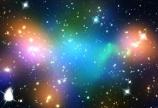Cosmic mystery deepens

In a study appearing in this month’s Astrophysical Journal, an international team of scientists—including an astrophysicist from the University of Victoria—use data from NASA’s Hubble Space Telescope to confirm the presence of a baffling gigantic clump of dark matter at the very heart of Abell 520, a “high-speed cosmic pile-up” involving multiple massive clusters of galaxies 2.4 billion light years from Earth.
The dark core was first discovered in 2007 by UVic astrophysicists. The discovery was so bizarre that most astronomers (including many in the discovery team) wished the result away, hoping it was a false signal.
“We were not expecting this,” says UVic astrophysicist Dr. Arif Babul, the team’s senior theorist. “According to our current theory, galaxies and dark matter are expected to stay together, even through a collision. But that’s not what’s happening in Abell 520. Here, the dark matter appears to have pooled to form the dark core, but most of the associated galaxies seem to have moved on. We had hoped when we got a better look at it with Hubble, the dark core would not be there. But instead it shows up with much greater significance than before.”
Dark matter—a mysterious invisible substance that accounts for 83 per cent of the matter in the universe—is thought to be the gravitational ‘glue’ that holds cosmic structures together. Its presence is detected through its gravitational tug on light beams and galaxies.
The result flies in the face of conventional understanding. The team has considered a number of possible solutions but each is as unsettling as the dark core itself. They are now looking to supercomputers to help recreate the collision in the hope that this will shed some light on the dark matter’s weird behavior.
NOTE: The blue-green area in the photo pinpoints the location of the dark matter clump.

